
langgraph4j
🚀 LangGraph for Java. A library for developing complex agent-based AI architectures in the Java ecosystem. Designed to work seamlessly with both Langchain4j and Spring AI.
Stars: 916
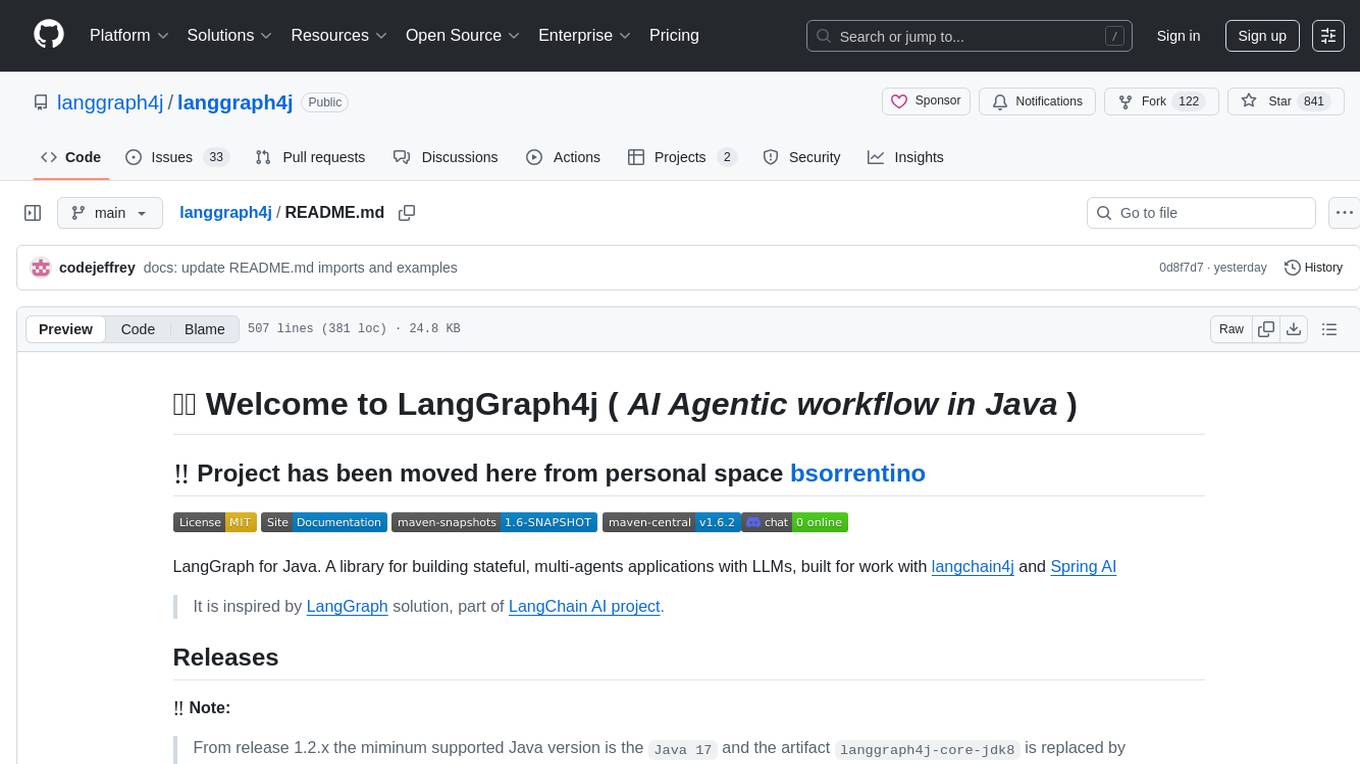
Langgraph4j is a Java library for language processing tasks such as text classification, sentiment analysis, and named entity recognition. It provides a set of tools and algorithms for analyzing text data and extracting useful information. The library is designed to be efficient and easy to use, making it suitable for both research and production applications.
README:
‼️ Project has been moved here from personal space bsorrentino
LangGraph for Java. A library for building stateful, multi-agents applications with LLMs, built for work with langchain4j and Spring AI
It is inspired by LangGraph solution, part of LangChain AI project.
From release 1.2.x the miminum supported Java version is the
Java 17and the artifactlanggraph4j-core-jdk8is replaced bylanggraph4j-core
| Date | Release | info |
|---|---|---|
| Sep 27, 2025 | 1.6.5 |
official release |
Welcome to LangGraph4j! This guide will help you understand the core concepts of LangGraph4j, install it, and build your first application.
LangGraph4j is a Java library for building stateful, multi-agent applications with Large Language Models (LLMs). It is inspired by the Python library LangGraph and is designed to work seamlessly with popular Java LLM frameworks like Langchain4j and Spring AI.
At its core, LangGraph4j allows you to define cyclical graphs where different components (agents, tools, or custom logic) can interact in a stateful manner. This is crucial for building complex applications that require memory, context, and the ability for different "agents" to collaborate or hand off tasks.
LangGraph4j offers several features and benefits:
- Stateful Execution: Manage and update a shared state across graph nodes, enabling memory and context awareness.
- Cyclical Graphs: Unlike traditional DAGs, LangGraph4j supports cycles, essential for agent-based architectures where control flow can loop back (e.g., an agent retrying a task or asking for clarification).
- Explicit Control Flow: Clearly define the paths and conditions for transitions between nodes in your graph.
- Modularity: Build complex systems from smaller, reusable components (nodes).
- Flexibility: Integrate with various LLM providers and custom Java logic.
-
Observability & Debugging:
- Checkpoints: Save the state of your graph at any point and replay or inspect it later. This is invaluable for debugging and understanding complex interactions.
- Graph Visualization: Generate visual representations of your graph using PlantUML or Mermaid to understand its structure.
- Asynchronous & Streaming Support: Build responsive applications with non-blocking operations and stream results from LLMs.
- Playground & Studio: A web UI to visually inspect, run, and debug your graphs.
Understanding these concepts is key to using LangGraph4j effectively:
The StateGraph is the primary class you'll use to define the structure of your application. It's where you add nodes and edges to create your graph. It is parameterized by an AgentState.
The AgentState (or a class extending it) represents the shared state of your graph. It's essentially a map (Map<String, Object>) that gets passed from node to node. Each node can read from this state and return updates to it.
-
Schema: The structure of the state is defined by a "schema," which is a
Map<String, Channel.Reducer>. Each key in the map corresponds to an attribute in the state. -
Channel.Reducer: A reducer defines how updates to a state attribute are handled. For example, a new value might overwrite the old one, or it might be added to a list of existing values. -
Channel.Default<T>: Provides a default value for a state attribute if it's not already set. -
Channel.Appender<T>/MessageChannel.Appender<M>: A common type of reducer that appends the new value to a list associated with the state attribute. This is useful for accumulating messages, tool calls, or other sequences of data.MessageChannel.Appenderis specifically designed for chat messages and can also handle message deletion by ID.
Nodes are the building blocks of your graph that perform actions. A node is typically a function (or a class implementing NodeAction<S> or AsyncNodeAction<S>) that:
- Receives the current
AgentStateas input. - Performs some computation (e.g., calls an LLM, executes a tool, runs custom business logic).
- Returns a
Map<String, Object>representing updates to the state. These updates are then applied to theAgentStateaccording to the schema's reducers.
Nodes can be synchronous or asynchronous (CompletableFuture).
Edges define the flow of control between nodes.
-
Normal Edges: An unconditional transition from one node to another. After node A completes, control always passes to node B. You define these with
addEdge(sourceNodeName, destinationNodeName). -
Conditional Edges: The next node is determined dynamically based on the current
AgentState. After a source node completes, anEdgeAction<S>(orAsyncEdgeAction<S>) function is executed. This function receives the current state and returns the name of the next node to execute. This allows for branching logic (e.g., if an agent decided to use a tool, go to the "execute_tool" node; otherwise, go to the "respond_to_user" node). Conditional edges are defined withaddConditionalEdges(...). -
Entry Points: You can also define conditional entry points to your graph using
addConditionalEntryPoint(...).
Once you've defined all your nodes and edges in a StateGraph, you compile() it into a CompiledGraph<S extends AgentState>. This compiled graph is an immutable, runnable representation of your logic. Compilation validates the graph structure (e.g., checks for orphaned nodes).
LangGraph4j allows you to save (Checkpoint) the state of your graph at any step. This is extremely useful for:
- Debugging: Inspect the state at various points to understand what happened.
- Resuming: Restore a graph to a previous state and continue execution.
-
Long-running processes: Persist the state of long-running agent interactions.
You'll typically use a
CheckpointSaverimplementation (e.g.,MemorySaverfor in-memory storage, or you can implement your own for persistent storage).
langgraph4j/
├── langgraph4j-bom/ # LangGraph4j dependency management
├── langgraph4j-core/ # LangGraph4j core components
├── langgraph4j-postgres-saver # LangGraph4j persistent checkpoint saver based on PostgresSQL
├── langchain4j/ # LangChain4j integration
│ ├── langchain4j-core/ # LangChain4j core components (integration required)
│ └── langchain4j-agent/ # LangChain4j agent executor
├── spring-ai/ # Spring AI integration
│ └── spring-ai-core/ # Spring AI core components (integration required)
│ └── spring-ai-agent/ # Spring AI agent executor
├── studio/ # LangGraph4j Studio (web UI)
│ └── base/ # Base classes and interfaces
│ └── jetty/ # Jetty server implementation
│ └── quarkus/ # Quarkus server implementation
│ └── springboot/ # Spring Boot implementation
├── how-tos/ # How-tos and examples, examples repository: https://github.com/langgraph4j/langgraph4j-examples
To use LangGraph4j in your project, you need to add it as a dependency.
Maven:
Make sure you are using Java 17 or later.
Latest Stable Version (Recommended):
<properties>
<langgraph4j.version>1.6.5</langgraph4j.version> <!-- Check for the actual latest version -->
</properties>
<!-- Optional: Add the Bill of Materials (BOM) to manage langgraph4j module versions -->
<dependencyManagement>
<dependencies>
<dependency>
<groupId>org.bsc.langgraph4j</groupId>
<artifactId>langgraph4j-bom</artifactId>
<version>${langgraph4j.version}</version>
<type>pom</type>
<scope>import</scope>
</dependency>
</dependencies>
</dependencyManagement>
<dependencies>
<dependency>
<groupId>org.bsc.langgraph4j</groupId>
<artifactId>langgraph4j-core</artifactId>
</dependency>
<!-- Add other langgraph4j modules if needed, e.g., langgraph4j-langchain4j -->
</dependencies>(Note: Always check the Maven Central Repository for the latest version number.)
Development Snapshot Version: If you want to use the latest unreleased features, you can use a snapshot version.
<dependency>
<groupId>org.bsc.langgraph4j</groupId>
<artifactId>langgraph4j-core</artifactId>
<version>1.6-SNAPSHOT</version> <!-- Or the current snapshot version -->
</dependency>You might need to configure your settings.xml or pom.xml to include the Sonatype OSS snapshots repository:
<repositories>
<repository>
<id>sonatype-oss-snapshots</id>
<url>https://central.sonatype.com/repository/maven-snapshots</url>
<snapshots>
<enabled>true</enabled>
</snapshots>
</repository>
</repositories>Let's create a very simple graph that has two nodes: greeter and responder.
The greeter node will add a greeting message to the state.
The responder node will add a response message based on the greeting.
1. Define the State: Our state will hold a list of messages.
import org.bsc.langgraph4j.state.AgentState;
import org.bsc.langgraph4j.state.Channels;
import org.bsc.langgraph4j.state.Channel;
import java.util.ArrayList;
import java.util.List;
import java.util.Map;
// Define the state for our graph
class SimpleState extends AgentState {
public static final String MESSAGES_KEY = "messages";
// Define the schema for the state.
// MESSAGES_KEY will hold a list of strings, and new messages will be appended.
public static final Map<String, Channel<?>> SCHEMA = Map.of(
MESSAGES_KEY, Channels.appender(ArrayList::new)
);
public SimpleState(Map<String, Object> initData) {
super(initData);
}
public List<String> messages() {
return this.<List<String>>value("messages")
.orElse( List.of() );
}
}2. Define the Nodes:
import org.bsc.langgraph4j.action.NodeAction;
import java.util.List;
import java.util.Map;
// Node that adds a greeting
class GreeterNode implements NodeAction<SimpleState> {
@Override
public Map<String, Object> apply(SimpleState state) {
System.out.println("GreeterNode executing. Current messages: " + state.messages());
return Map.of(SimpleState.MESSAGES_KEY, "Hello from GreeterNode!");
}
}
// Node that adds a response
class ResponderNode implements NodeAction<SimpleState> {
@Override
public Map<String, Object> apply(SimpleState state) {
System.out.println("ResponderNode executing. Current messages: " + state.messages());
List<String> currentMessages = state.messages();
if (currentMessages.contains("Hello from GreeterNode!")) {
return Map.of(SimpleState.MESSAGES_KEY, "Acknowledged greeting!");
}
return Map.of(SimpleState.MESSAGES_KEY, "No greeting found.");
}
}3. Define and Compile the Graph:
import org.bsc.langgraph4j.StateGraph;
import org.bsc.langgraph4j.GraphStateException;
import static org.bsc.langgraph4j.action.AsyncNodeAction.node_async;
import static org.bsc.langgraph4j.StateGraph.START;
import static org.bsc.langgraph4j.StateGraph.END;
import java.util.Map;
public class SimpleGraphApp {
public static void main(String[] args) throws GraphStateException {
// Initialize nodes
GreeterNode greeterNode = new GreeterNode();
ResponderNode responderNode = new ResponderNode();
// Define the graph structure
var stateGraph = new StateGraph<>(SimpleState.SCHEMA, initData -> new SimpleState(initData))
.addNode("greeter", node_async(greeterNode))
.addNode("responder", node_async(responderNode))
// Define edges
.addEdge(START, "greeter") // Start with the greeter node
.addEdge("greeter", "responder")
.addEdge("responder", END) // End after the responder node
;
// Compile the graph
var compiledGraph = stateGraph.compile();
// Run the graph
// The `stream` method returns an AsyncGenerator.
// For simplicity, we'll collect results. In a real app, you might process them as they arrive.
// Here, the final state after execution is the item of interest.
for (var item : compiledGraph.stream( Map.of( SimpleState.MESSAGES_KEY, "Let's, begin!" ) ) ) {
System.out.println( item );
}
}
}Explanation:
- We defined
SimpleStatewith aMESSAGES_KEYthat usesAppenderChannelto accumulate strings. -
GreeterNodeadds a "Hello" message. -
ResponderNodechecks for the greeting and adds an acknowledgment. - The
StateGraphis defined, nodes are added, and edges specify the flow:START->greeter->responder->END. -
stateGraph.compile()creates the runnableCompiledGraph. -
compiledGraph.stream(initialState)executes the graph. We iterate through the stream to get the final state. Each item in the stream represents the state after a node has executed.
This example demonstrates the basic workflow: define state, define nodes, wire them with edges, compile, and run.
As shown in the example, you typically run a compiled graph using one of its execution methods:
-
stream(S initialState, RunnableConfig config): Executes the graph and returns anAsyncGenerator<S>. Each yielded item is the stateSafter a node has completed. This is useful for observing the state at each step or for streaming partial results. -
invoke(S initialState, RunnableConfig config): Executes the graph and returns aCompletableFuture<S>that completes with the final state of the graph after it reaches anENDnode.
The RunnableConfig can be used to pass in runtime configuration.
Langgraph4j Studio is an embeddable web application for visualizing and experimenting with graphs:
To explore the Langgraph4j Studio go to studio
As default use case to proof LangChain4j integration, We have implemented AgentExecutor (aka ReACT Agent) using LangGraph4j. In the project's module, you can the complete working code with tests. Feel free to checkout and use it as a reference.
Below usage example of the AgentExecutor.
public class TestTool {
@Tool("tool for test AI agent executor")
String execTest(@P("test message") String message) {
return format( "test tool ('%s') executed with result 'OK'", message);
}
@Tool("return current number of system thread allocated by application")
int threadCount() {
return Thread.getAllStackTraces().size();
}
}var model = OllamaChatModel.builder()
.modelName( "qwen2.5:7b" )
.baseUrl("http://localhost:11434")
.supportedCapabilities(Capability.RESPONSE_FORMAT_JSON_SCHEMA)
.logRequests(true)
.logResponses(true)
.maxRetries(2)
.temperature(0.0)
.build();
var agent = AgentExecutor.builder()
.chatModel(model)
.toolsFromObject(new TestTool())
.build()
.compile();
for (var item : agent.stream( Map.of( "messages", "perform test twice and return number of current active threads" ) ) ) {
System.out.println( item );
}As default use case to proof Spring AI integration, We have implemented AgentExecutor (aka ReACT Agent) using LangGraph4j. In the project's module, you can the complete working code with tests. Feel free to checkout and use it as a reference.
Below usage example of the AgentExecutor.
public class TestTool {
@Tool(description = "tool for test AI agent executor")
String execTest( @ToolParam(description ="test message") String message ) {
return format( "test tool ('%s') executed with result 'OK'", message);
}
@Tool(description = "return current number of system thread allocated by application")
int threadCount() {
return Thread.getAllStackTraces().size();
}
}var model = OllamaChatModel.builder()
.ollamaApi(OllamaApi.builder().baseUrl("http://localhost:11434").build())
.defaultOptions(OllamaOptions.builder()
.model("qwen2.5:7b")
.temperature(0.1)
.build())
.build();
var agent = AgentExecutor.builder()
.chatModel(model)
.toolsFromObject(new TestTool())
.build()
.compile()
;
for (var item : agent.stream( Map.of( "messages", "perform test twice and return number of current active threads" ) ) ) {
System.out.println( item );
}LangGraph4j is packed with features to build sophisticated agentic applications:
-
Asynchronous Operations: Nodes and edges can be asynchronous (returning
CompletableFuture), allowing for non-blocking I/O operations, especially when dealing with LLM calls. - Streaming: Natively supports streaming responses from LLMs through nodes, enabling real-time output. See how-tos/llm-streaming.ipynb.
- Checkpoints (Persistence & Time Travel): Save and load the state of your graph. This allows you to resume long-running tasks, debug by inspecting intermediate states, and even "time travel" to previous states. See how-tos/persistence.ipynb and how-tos/time-travel.ipynb.
- Graph Visualization: Generate PlantUML or Mermaid diagrams of your graph to visualize its structure, which aids in understanding and debugging. See how-tos/plantuml.ipynb.
- Playground & Studio: LangGraph4j comes with an embeddable web UI (Studio) that allows you to visualize, run, and interact with your graphs in real-time. This is excellent for development and debugging.
- Child Graphs (Subgraphs): Compose complex graphs by nesting smaller, reusable graphs within nodes of a parent graph. This promotes modularity and reusability. See how-tos/subgraph-as-nodeaction.ipynb, how-tos/subgraph-as-compiledgraph.ipynb, and how-tos/subgraph-as-stategraph.ipynb.
- Parallel Execution: Configure parts of your graph to execute multiple nodes in parallel, improving performance for tasks that can be run concurrently. See [how-tos/parallel-branch.ipynb].
- Threads (Multi-turn Conversations): Manage distinct, parallel execution threads within a single graph instance, each with its own checkpoint history. This is vital for handling multiple user sessions or conversations simultaneously.
Now that you have a basic understanding of LangGraph4j, here's how you can continue your journey:
-
Explore the
how-to: Thehow-tos/directory in the repository contains Jupyter notebooks (runnable with Java kernels like IJava) that demonstrate various features with code examples. - Study the Examples: Check out the examples from here for more complete application examples, including integrations with Langchain4j and Spring AI.
- Consult the Javadocs: For detailed information on classes and methods, refer to the API documentation (Javadocs). (Link might need updating if official project documentation site changes)
- Experiment! The best way to learn is by doing. Try modifying the examples or building your own simple graphs.
We hope this guide helps you get started with LangGraph4j. Happy building!
- LangGraph4j Meets AG-UI - Building UI/UX in AI Agents era
- LangGraph4j - Implementing Human-in-the-Loop at ease
- LangGraph4j - Multi-Agent handoff implementation with Spring AI
- Microsoft JDConf 2025 - AI Agents Graph: Your following tool in your Java AI journey
- Enhancing AI Agent Development: A Hands-On Weekend with LangGraph4J
- LangGraph4j Generator - Visually scaffold LangGraph Java code
- AI Agent in Java with LangGraph4j
- Building Stateful Multi AI Agents -LangGraph4J & Spring AI
- A deep research assistant based on the Langgraph4j
- research4j - Build your own perplexity for your applications
- Multi Agent Banking Assistant with Java using Langraph4j
- Java Async Generator, a Java version of Javascript async generator
- AIDEEPIN: Ai-based productivity tools (Chat,Draw,RAG,Workflow etc)
- Dynamo Multi AI Agent POC: Unlock the Power of Spring AI and LangGraph4J
- LangChain4j & LangGraph4j Integrate LangFuse
For Tasks:
Click tags to check more tools for each tasksFor Jobs:
Alternative AI tools for langgraph4j
Similar Open Source Tools

langgraph4j
Langgraph4j is a Java library for language processing tasks such as text classification, sentiment analysis, and named entity recognition. It provides a set of tools and algorithms for analyzing text data and extracting useful information. The library is designed to be efficient and easy to use, making it suitable for both research and production applications.
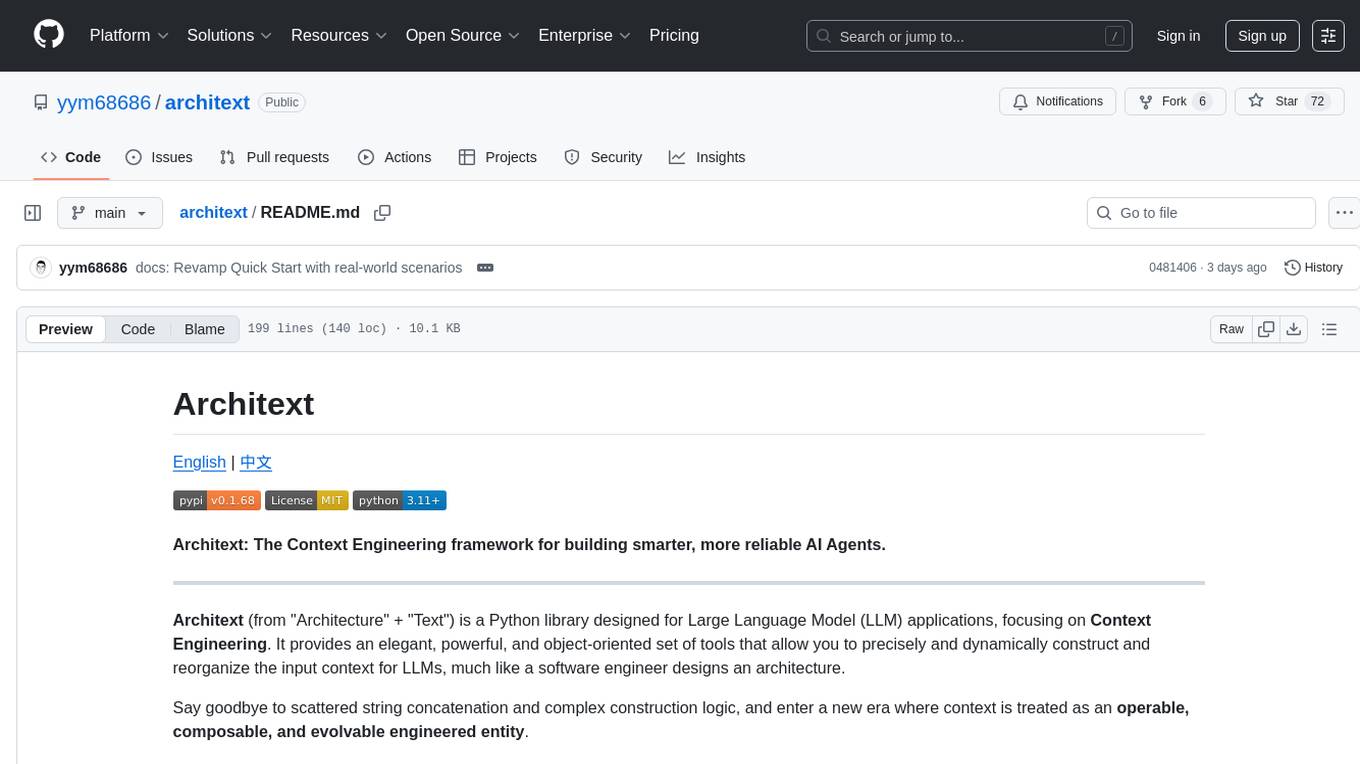
architext
Architext is a Python library designed for Large Language Model (LLM) applications, focusing on Context Engineering. It provides tools to construct and reorganize input context for LLMs dynamically. The library aims to elevate context construction from ad-hoc to systematic engineering, enabling precise manipulation of context content for AI Agents.
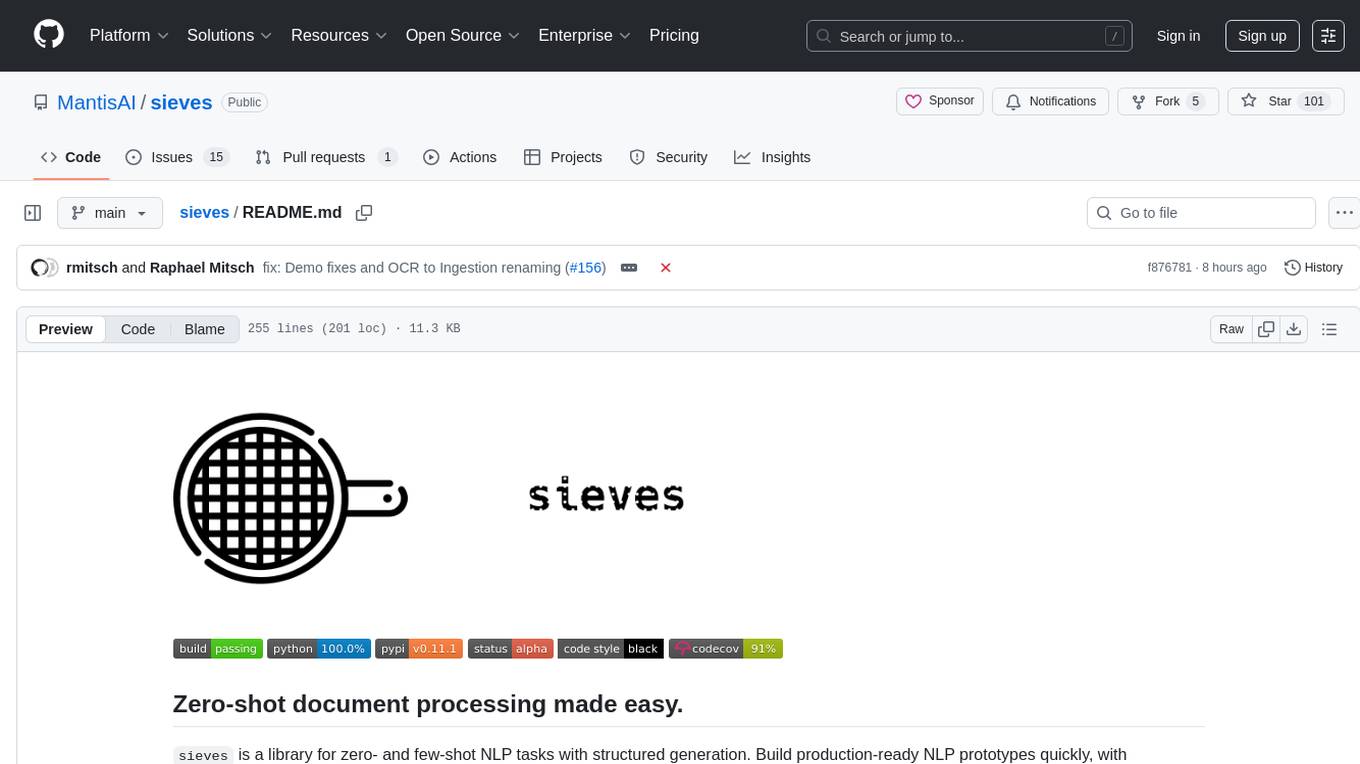
sieves
sieves is a library for zero- and few-shot NLP tasks with structured generation, enabling rapid prototyping of NLP applications without the need for training. It simplifies NLP prototyping by bundling capabilities into a single library, providing zero- and few-shot model support, a unified interface for structured generation, built-in tasks for common NLP operations, easy extendability, document-based pipeline architecture, caching to prevent redundant model calls, and more. The tool draws inspiration from spaCy and spacy-llm, offering features like immediate inference, observable pipelines, integrated tools for document parsing and text chunking, ready-to-use tasks such as classification, summarization, translation, and more, persistence for saving and loading pipelines, distillation for specialized model creation, and caching to optimize performance.
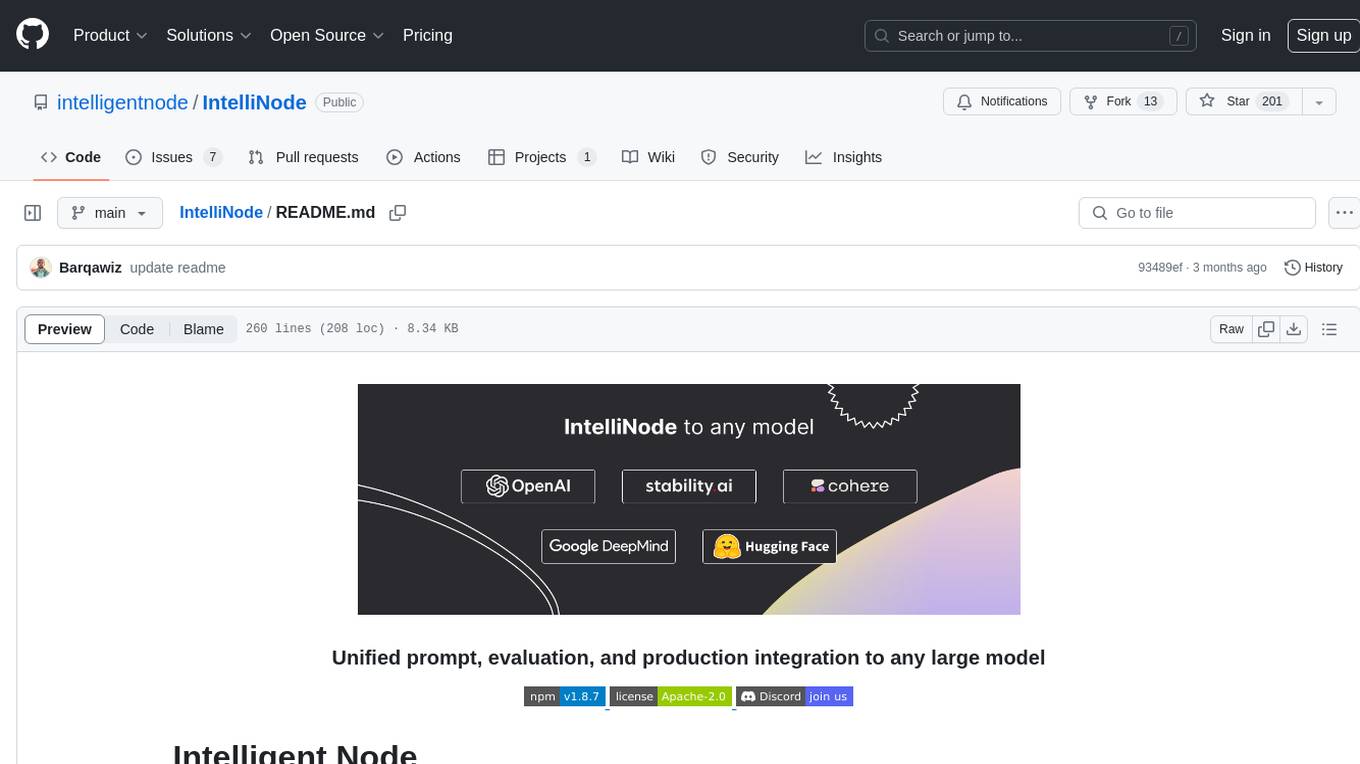
IntelliNode
IntelliNode is a javascript module that integrates cutting-edge AI models like ChatGPT, LLaMA, WaveNet, Gemini, and Stable diffusion into projects. It offers functions for generating text, speech, and images, as well as semantic search, multi-model evaluation, and chatbot capabilities. The module provides a wrapper layer for low-level model access, a controller layer for unified input handling, and a function layer for abstract functionality tailored to various use cases.
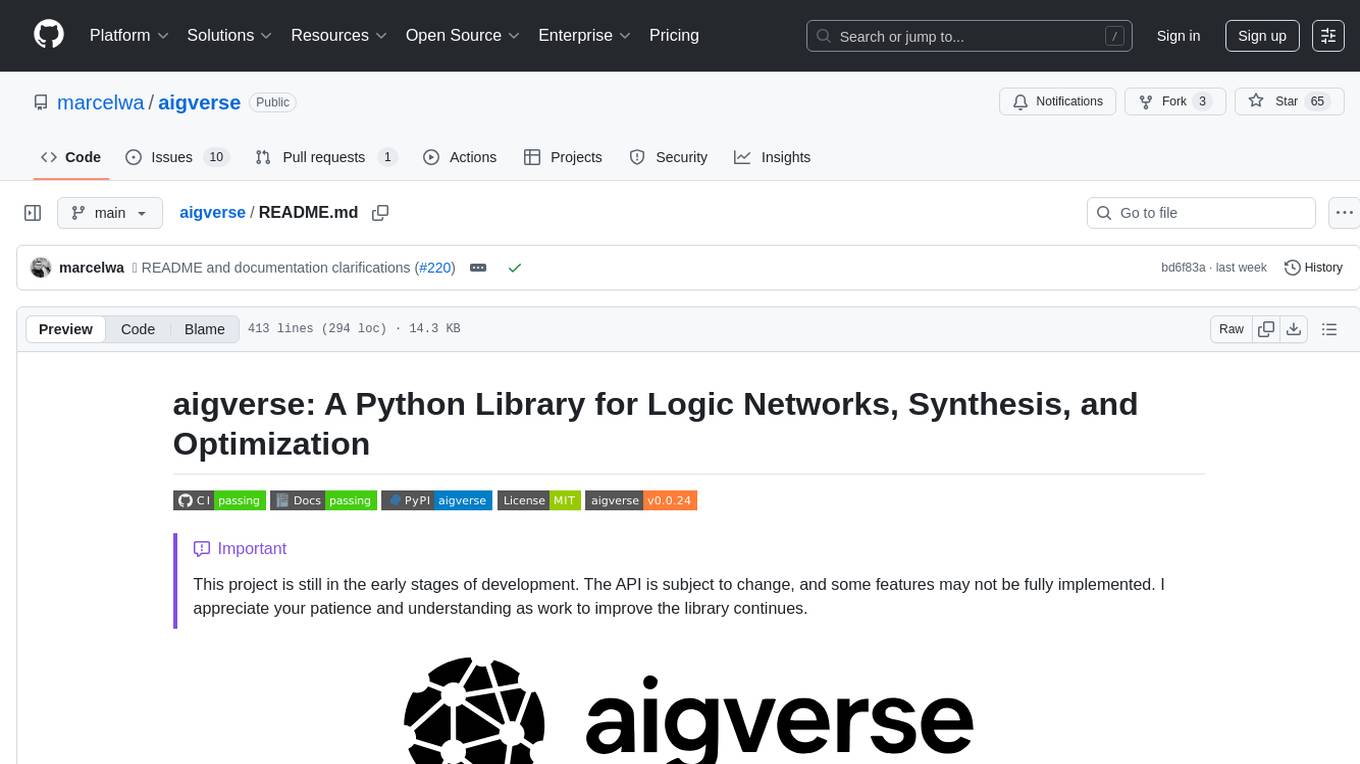
aigverse
aigverse is a Python infrastructure framework that bridges the gap between logic synthesis and AI/ML applications. It allows efficient representation and manipulation of logic circuits, making it easier to integrate logic synthesis and optimization tasks into machine learning pipelines. Built upon EPFL Logic Synthesis Libraries, particularly mockturtle, aigverse provides a high-level Python interface to state-of-the-art algorithms for And-Inverter Graph (AIG) manipulation and logic synthesis, widely used in formal verification, hardware design, and optimization tasks.
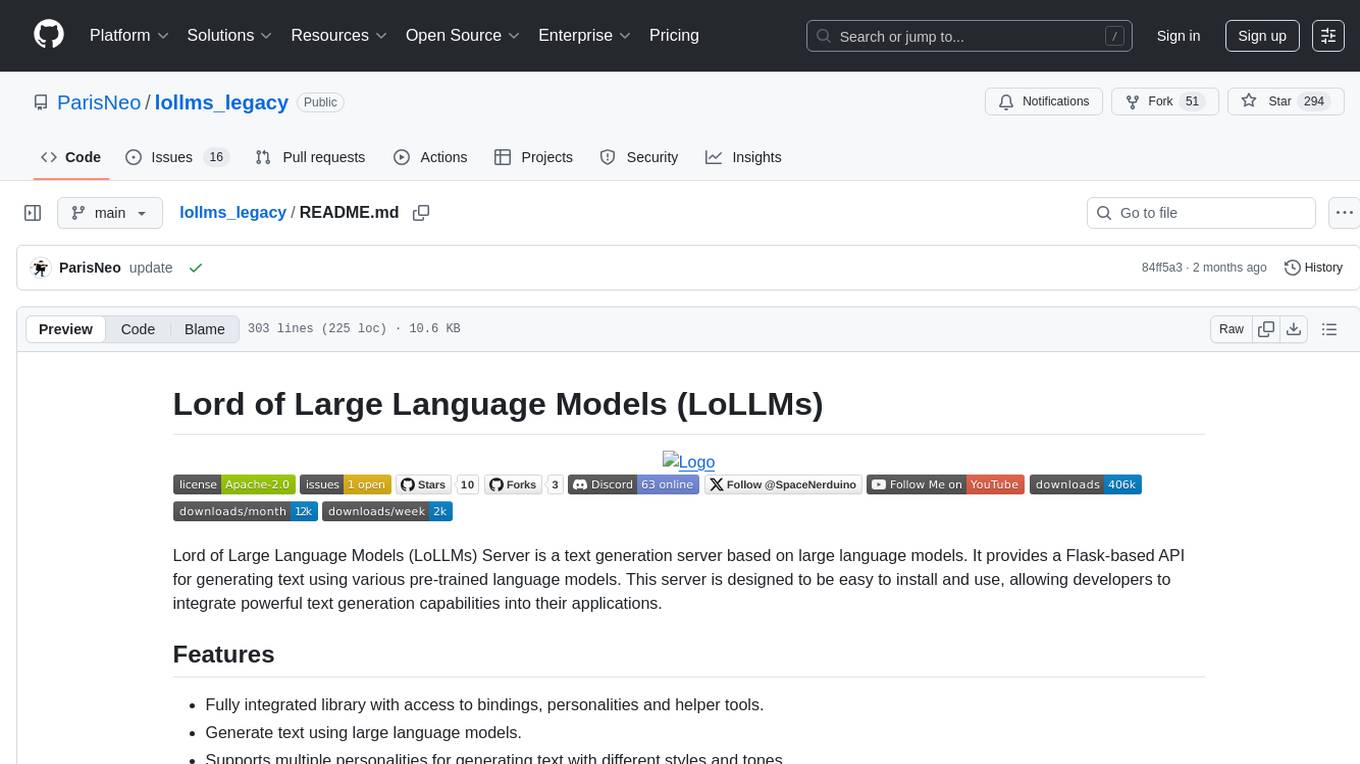
lollms_legacy
Lord of Large Language Models (LoLLMs) Server is a text generation server based on large language models. It provides a Flask-based API for generating text using various pre-trained language models. This server is designed to be easy to install and use, allowing developers to integrate powerful text generation capabilities into their applications. The tool supports multiple personalities for generating text with different styles and tones, real-time text generation with WebSocket-based communication, RESTful API for listing personalities and adding new personalities, easy integration with various applications and frameworks, sending files to personalities, running on multiple nodes to provide a generation service to many outputs at once, and keeping data local even in the remote version.

weave
Weave is a toolkit for developing Generative AI applications, built by Weights & Biases. With Weave, you can log and debug language model inputs, outputs, and traces; build rigorous, apples-to-apples evaluations for language model use cases; and organize all the information generated across the LLM workflow, from experimentation to evaluations to production. Weave aims to bring rigor, best-practices, and composability to the inherently experimental process of developing Generative AI software, without introducing cognitive overhead.
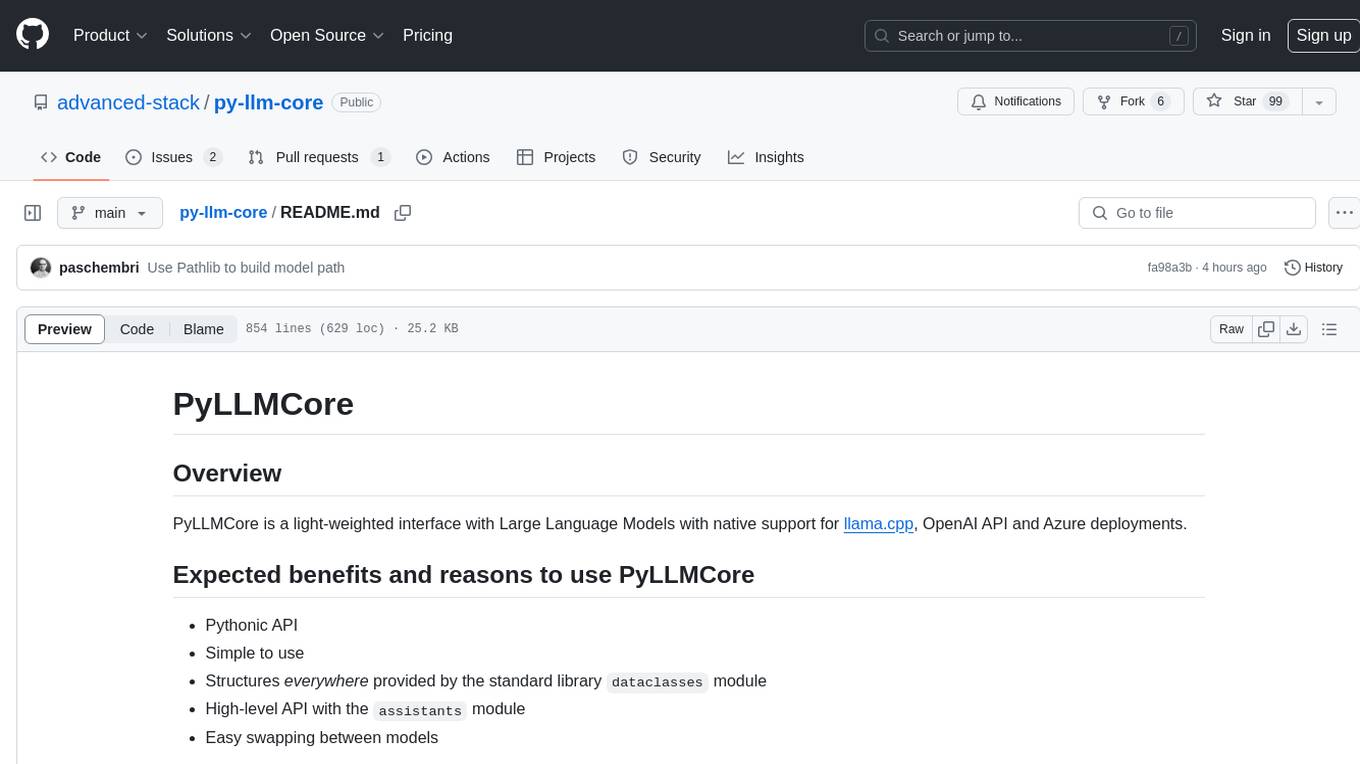
py-llm-core
PyLLMCore is a light-weighted interface with Large Language Models with native support for llama.cpp, OpenAI API, and Azure deployments. It offers a Pythonic API that is simple to use, with structures provided by the standard library dataclasses module. The high-level API includes the assistants module for easy swapping between models. PyLLMCore supports various models including those compatible with llama.cpp, OpenAI, and Azure APIs. It covers use cases such as parsing, summarizing, question answering, hallucinations reduction, context size management, and tokenizing. The tool allows users to interact with language models for tasks like parsing text, summarizing content, answering questions, reducing hallucinations, managing context size, and tokenizing text.
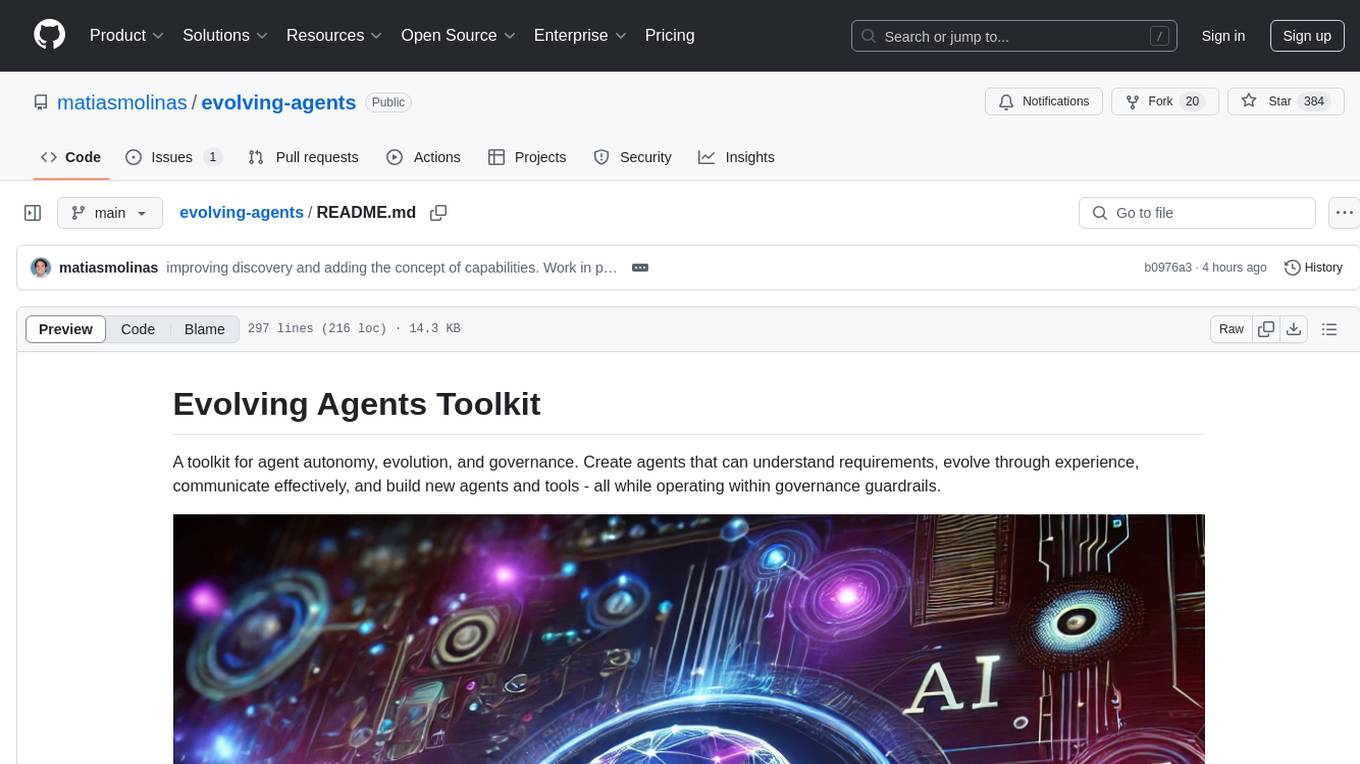
evolving-agents
A toolkit for agent autonomy, evolution, and governance enabling agents to learn from experience, collaborate, communicate, and build new tools within governance guardrails. It focuses on autonomous evolution, agent self-discovery, governance firmware, self-building systems, and agent-centric architecture. The toolkit leverages existing frameworks to enable agent autonomy and self-governance, moving towards truly autonomous AI systems.
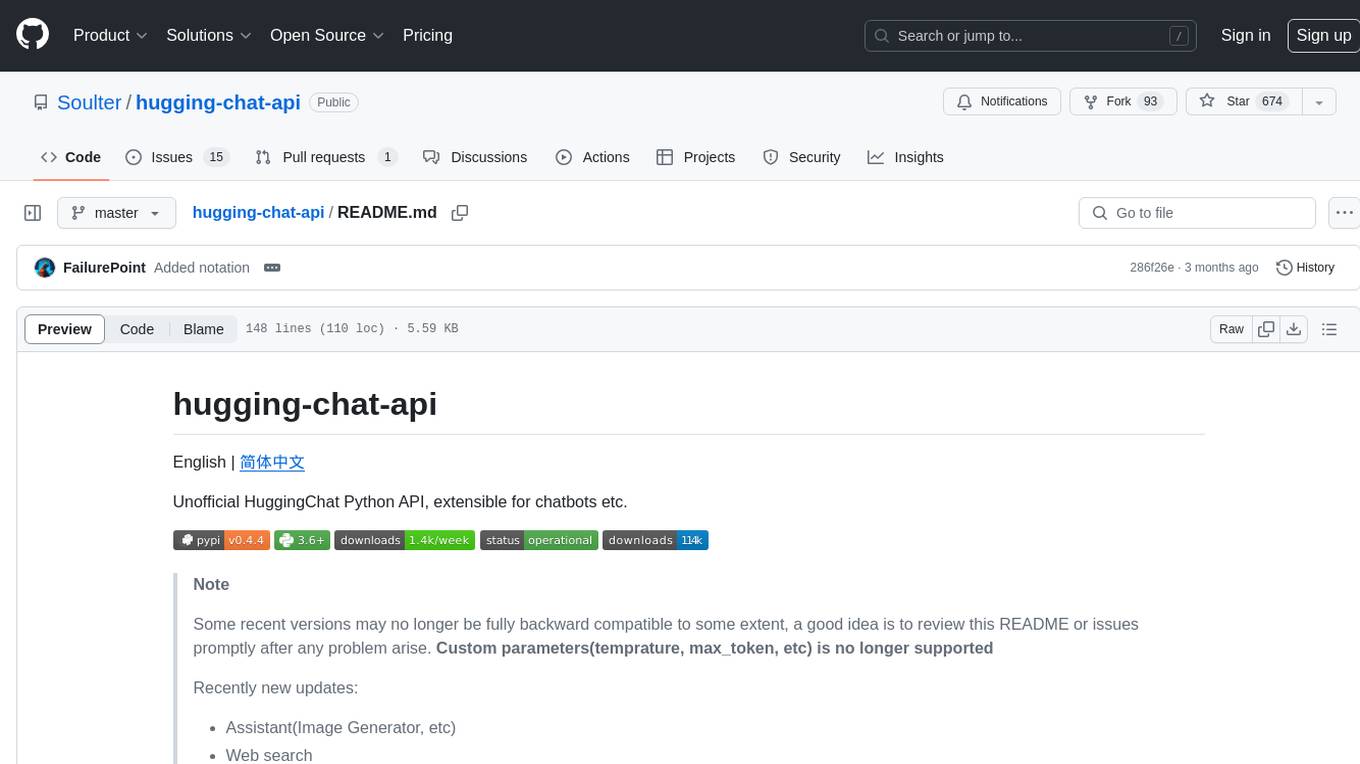
hugging-chat-api
Unofficial HuggingChat Python API for creating chatbots, supporting features like image generation, web search, memorizing context, and changing LLMs. Users can log in, chat with the ChatBot, perform web searches, create new conversations, manage conversations, switch models, get conversation info, use assistants, and delete conversations. The API also includes a CLI mode with various commands for interacting with the tool. Users are advised not to use the application for high-stakes decisions or advice and to avoid high-frequency requests to preserve server resources.
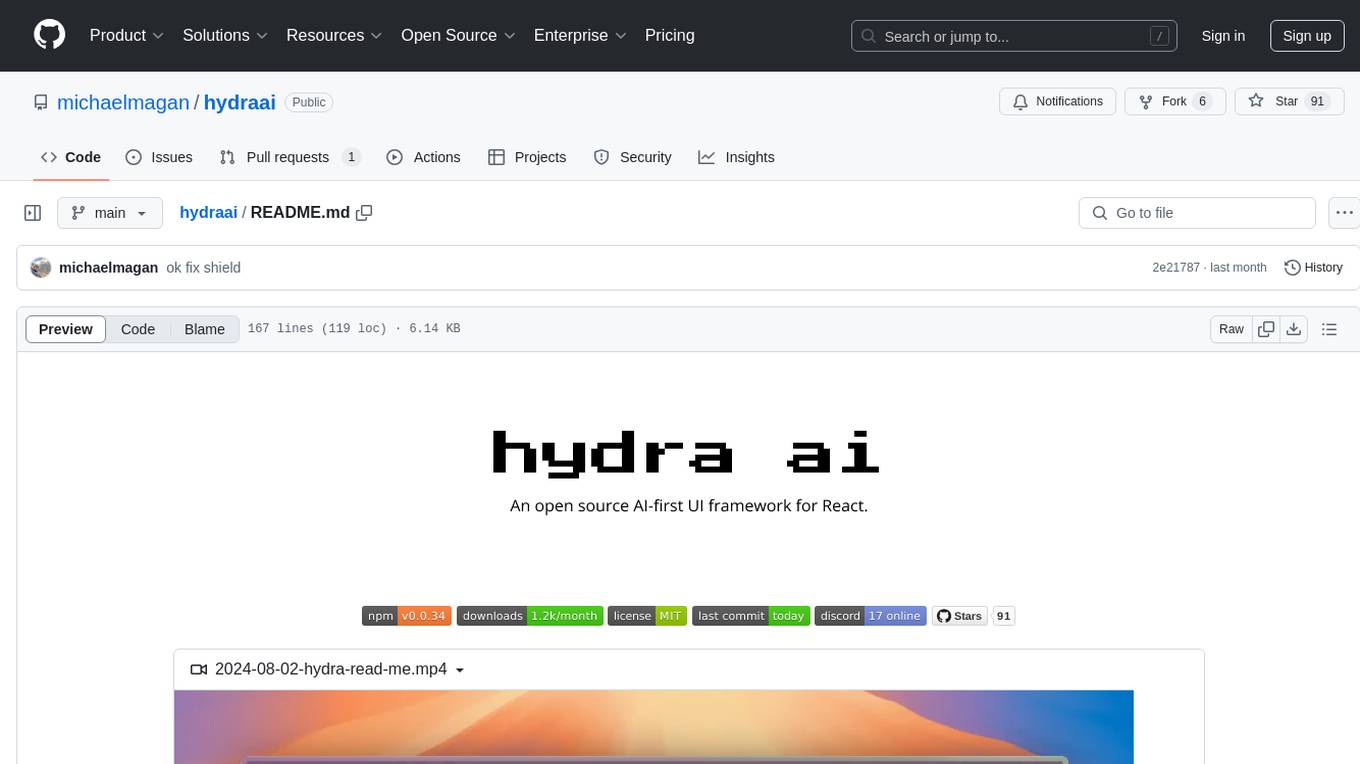
hydraai
Generate React components on-the-fly at runtime using AI. Register your components, and let Hydra choose when to show them in your App. Hydra development is still early, and patterns for different types of components and apps are still being developed. Join the discord to chat with the developers. Expects to be used in a NextJS project. Components that have function props do not work.
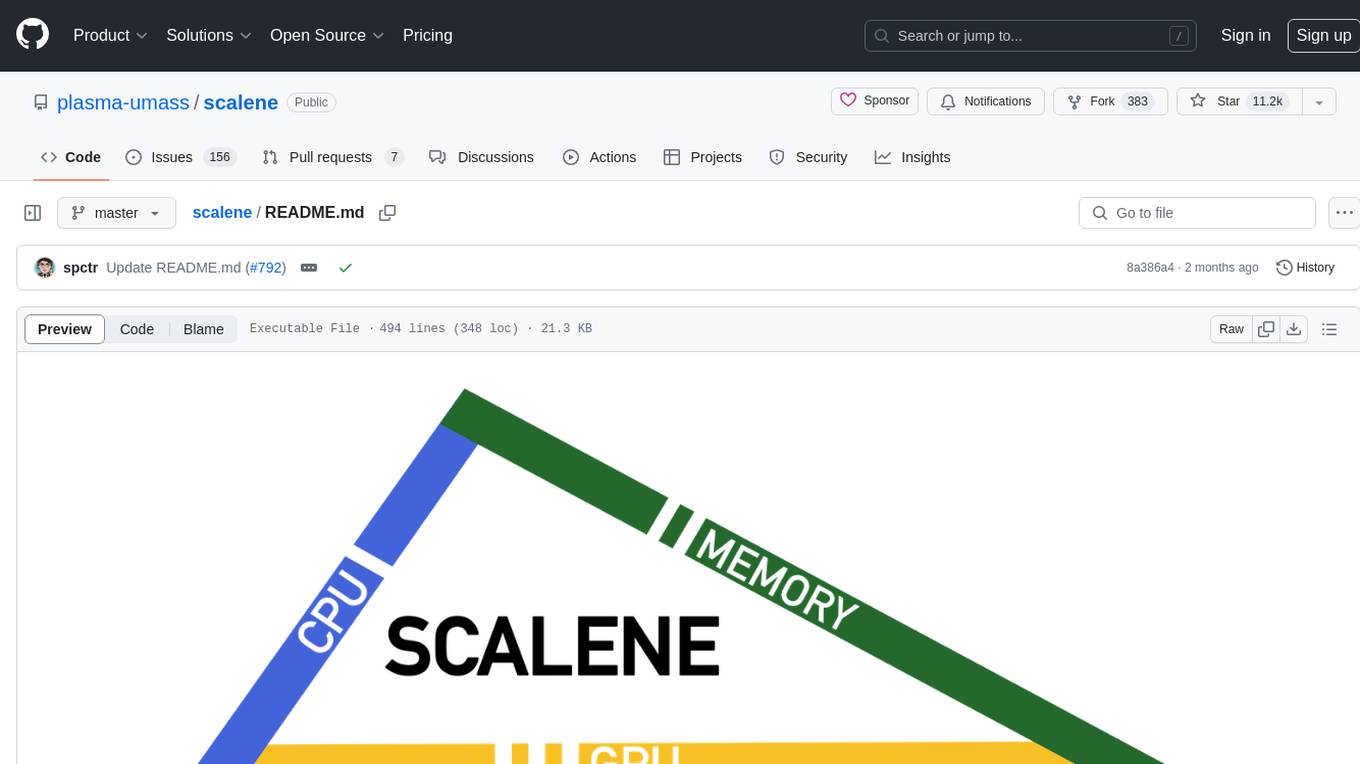
scalene
Scalene is a high-performance CPU, GPU, and memory profiler for Python that provides detailed information and runs faster than many other profilers. It incorporates AI-powered proposed optimizations, allowing users to generate optimization suggestions by clicking on specific lines or regions of code. Scalene separates time spent in Python from native code, highlights hotspots, and identifies memory usage per line. It supports GPU profiling on NVIDIA-based systems and detects memory leaks. Users can generate reduced profiles, profile specific functions using decorators, and suspend/resume profiling for background processes. Scalene is available as a pip or conda package and works on various platforms. It offers features like profiling at the line level, memory trends, copy volume reporting, and leak detection.

req_llm
ReqLLM is a Req-based library for LLM interactions, offering a unified interface to AI providers through a plugin-based architecture. It brings composability and middleware advantages to LLM interactions, with features like auto-synced providers/models, typed data structures, ergonomic helpers, streaming capabilities, usage & cost extraction, and a plugin-based provider system. Users can easily generate text, structured data, embeddings, and track usage costs. The tool supports various AI providers like Anthropic, OpenAI, Groq, Google, and xAI, and allows for easy addition of new providers. ReqLLM also provides API key management, detailed documentation, and a roadmap for future enhancements.
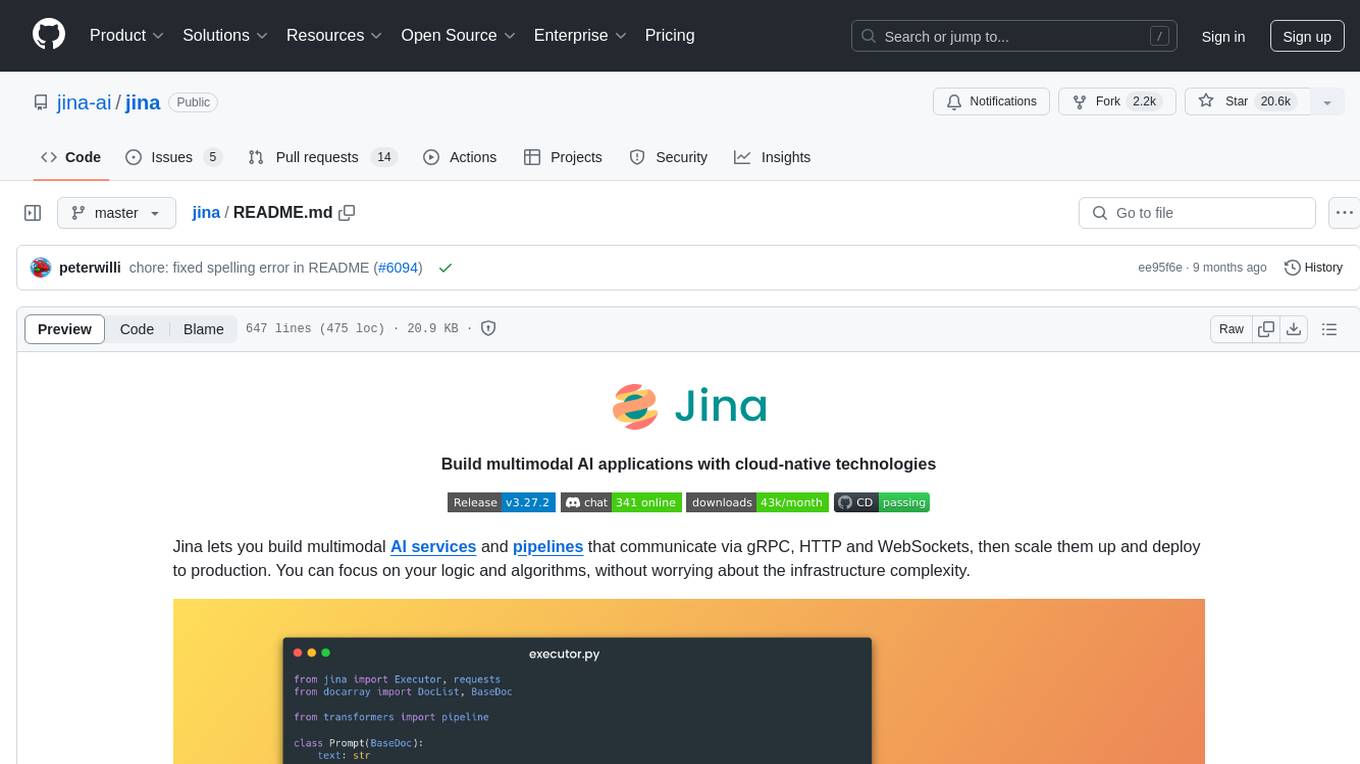
jina
Jina is a tool that allows users to build multimodal AI services and pipelines using cloud-native technologies. It provides a Pythonic experience for serving ML models and transitioning from local deployment to advanced orchestration frameworks like Docker-Compose, Kubernetes, or Jina AI Cloud. Users can build and serve models for any data type and deep learning framework, design high-performance services with easy scaling, serve LLM models while streaming their output, integrate with Docker containers via Executor Hub, and host on CPU/GPU using Jina AI Cloud. Jina also offers advanced orchestration and scaling capabilities, a smooth transition to the cloud, and easy scalability and concurrency features for applications. Users can deploy to their own cloud or system with Kubernetes and Docker Compose integration, and even deploy to JCloud for autoscaling and monitoring.
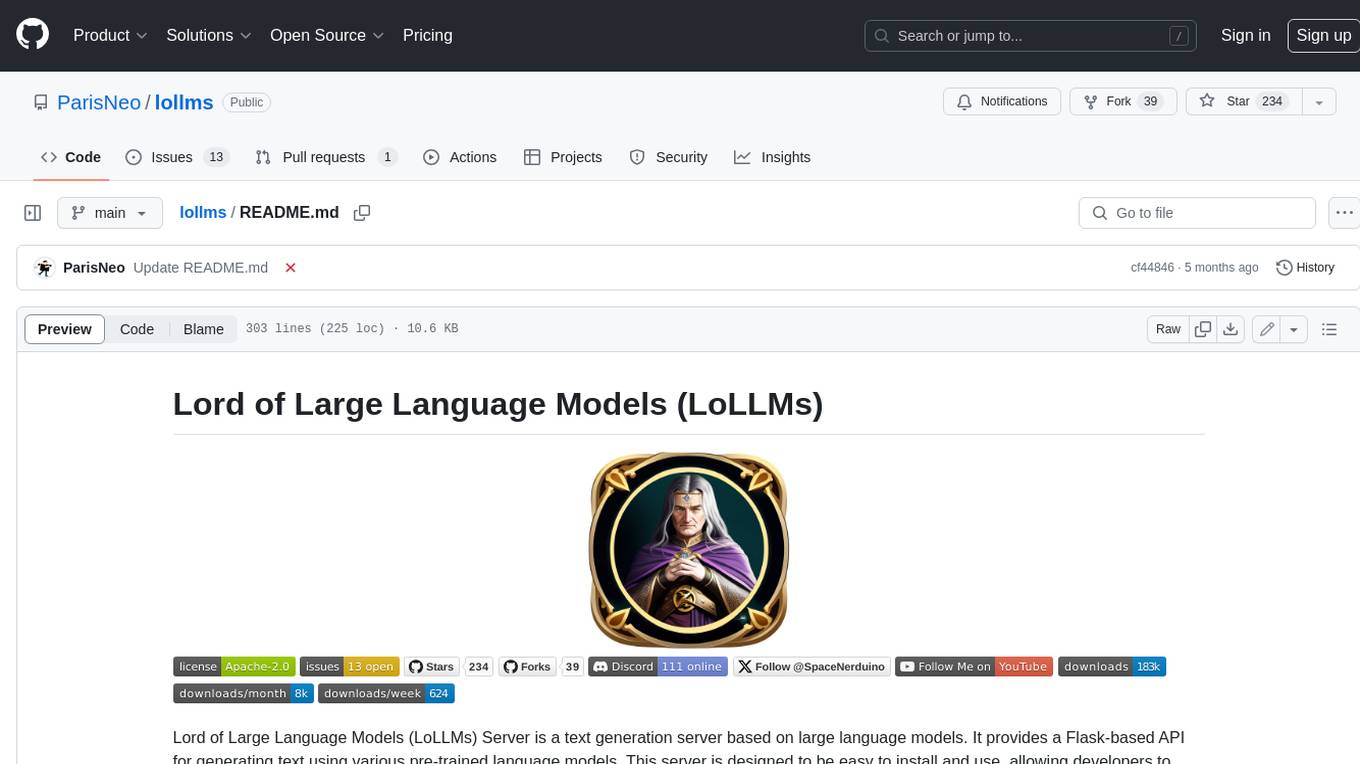
lollms
LoLLMs Server is a text generation server based on large language models. It provides a Flask-based API for generating text using various pre-trained language models. This server is designed to be easy to install and use, allowing developers to integrate powerful text generation capabilities into their applications.

Fabric
Fabric is an open-source framework designed to augment humans using AI by organizing prompts by real-world tasks. It addresses the integration problem of AI by creating and organizing prompts for various tasks. Users can create, collect, and organize AI solutions in a single place for use in their favorite tools. Fabric also serves as a command-line interface for those focused on the terminal. It offers a wide range of features and capabilities, including support for multiple AI providers, internationalization, speech-to-text, AI reasoning, model management, web search, text-to-speech, desktop notifications, and more. The project aims to help humans flourish by leveraging AI technology to solve human problems and enhance creativity.
For similar tasks
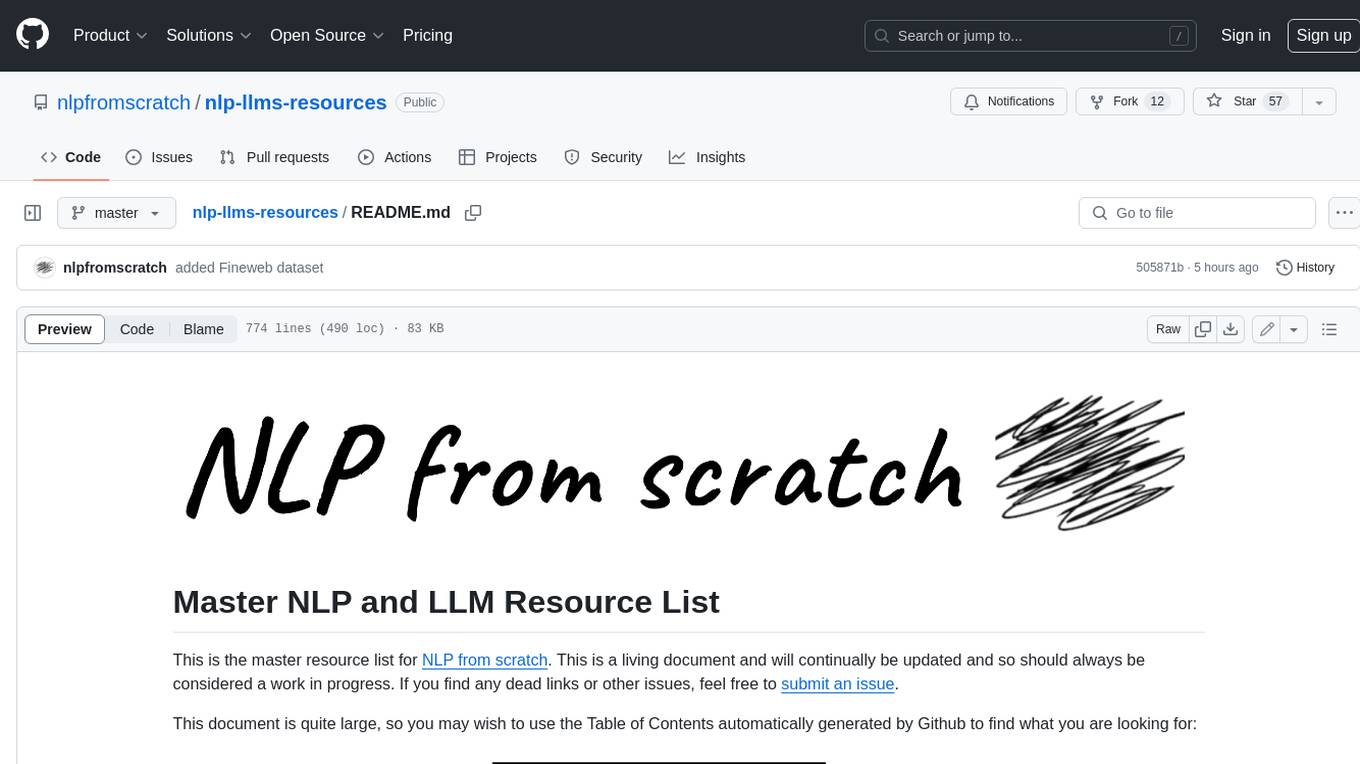
nlp-llms-resources
The 'nlp-llms-resources' repository is a comprehensive resource list for Natural Language Processing (NLP) and Large Language Models (LLMs). It covers a wide range of topics including traditional NLP datasets, data acquisition, libraries for NLP, neural networks, sentiment analysis, optical character recognition, information extraction, semantics, topic modeling, multilingual NLP, domain-specific LLMs, vector databases, ethics, costing, books, courses, surveys, aggregators, newsletters, papers, conferences, and societies. The repository provides valuable information and resources for individuals interested in NLP and LLMs.
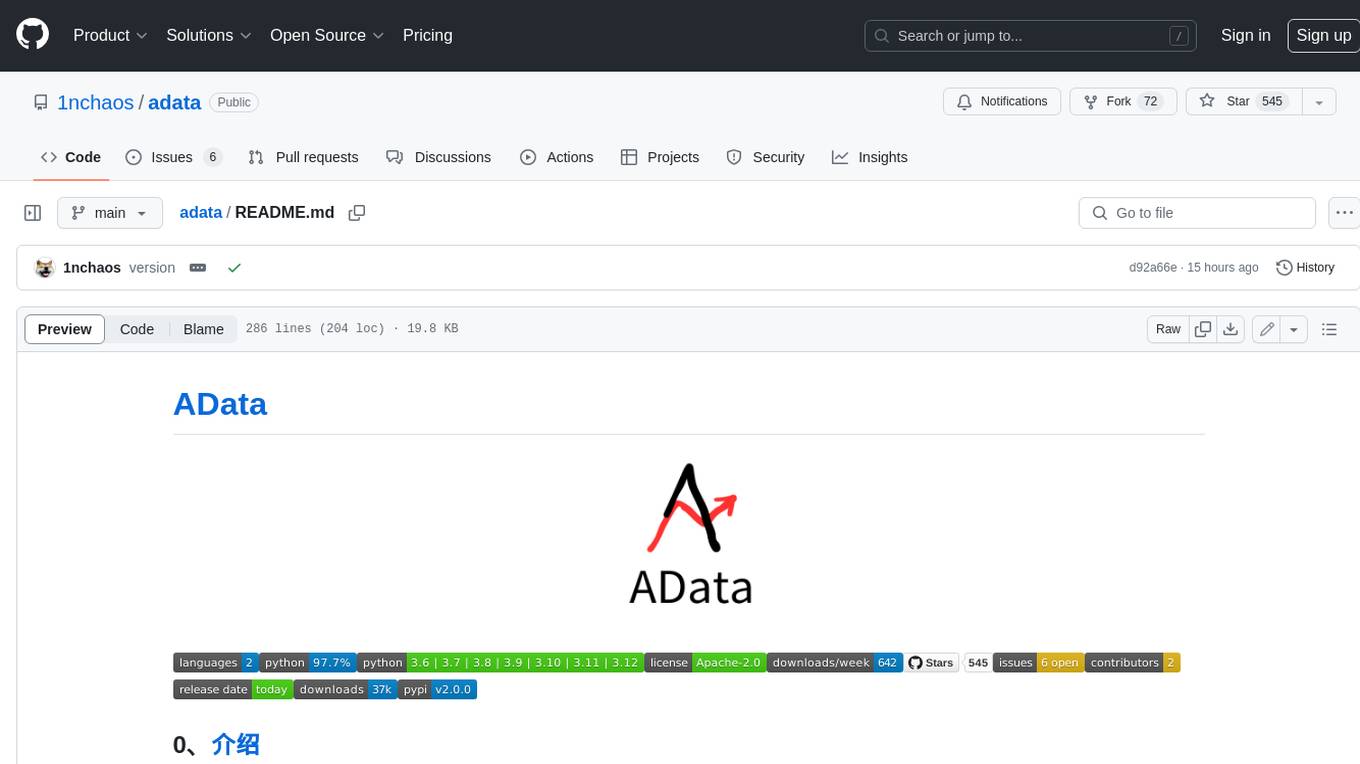
adata
AData is a free and open-source A-share database that focuses on transaction-related data. It provides comprehensive data on stocks, including basic information, market data, and sentiment analysis. AData is designed to be easy to use and integrate with other applications, making it a valuable tool for quantitative trading and AI training.

PIXIU
PIXIU is a project designed to support the development, fine-tuning, and evaluation of Large Language Models (LLMs) in the financial domain. It includes components like FinBen, a Financial Language Understanding and Prediction Evaluation Benchmark, FIT, a Financial Instruction Dataset, and FinMA, a Financial Large Language Model. The project provides open resources, multi-task and multi-modal financial data, and diverse financial tasks for training and evaluation. It aims to encourage open research and transparency in the financial NLP field.
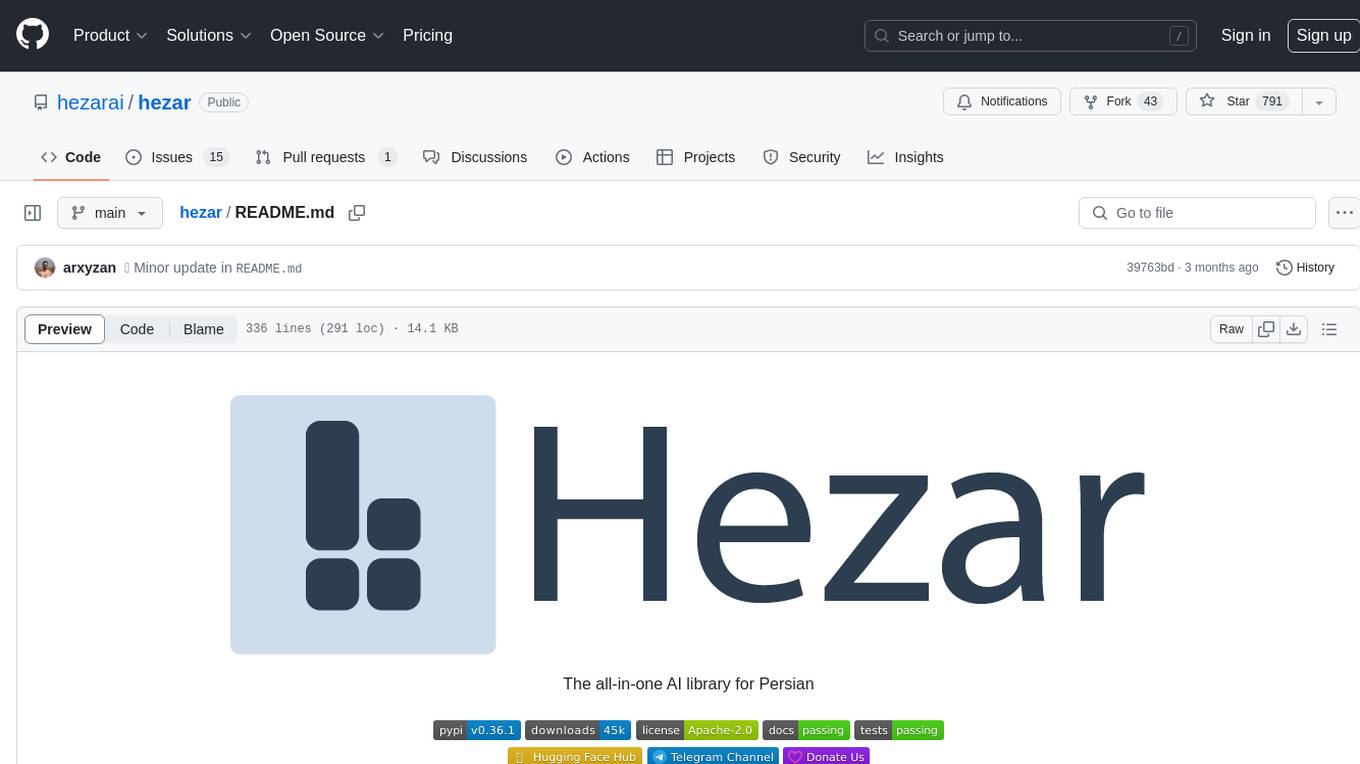
hezar
Hezar is an all-in-one AI library designed specifically for the Persian community. It brings together various AI models and tools, making it easy to use AI with just a few lines of code. The library seamlessly integrates with Hugging Face Hub, offering a developer-friendly interface and task-based model interface. In addition to models, Hezar provides tools like word embeddings, tokenizers, feature extractors, and more. It also includes supplementary ML tools for deployment, benchmarking, and optimization.
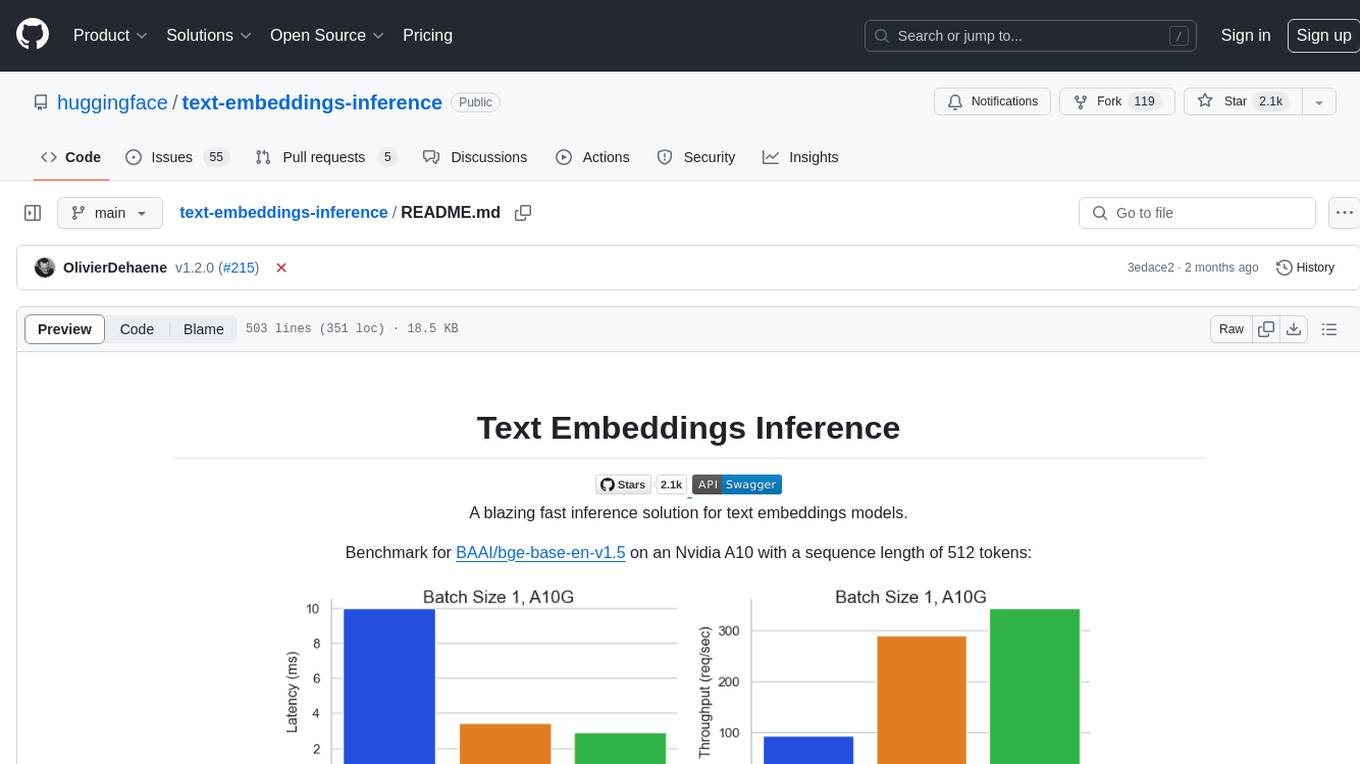
text-embeddings-inference
Text Embeddings Inference (TEI) is a toolkit for deploying and serving open source text embeddings and sequence classification models. TEI enables high-performance extraction for popular models like FlagEmbedding, Ember, GTE, and E5. It implements features such as no model graph compilation step, Metal support for local execution on Macs, small docker images with fast boot times, token-based dynamic batching, optimized transformers code for inference using Flash Attention, Candle, and cuBLASLt, Safetensors weight loading, and production-ready features like distributed tracing with Open Telemetry and Prometheus metrics.
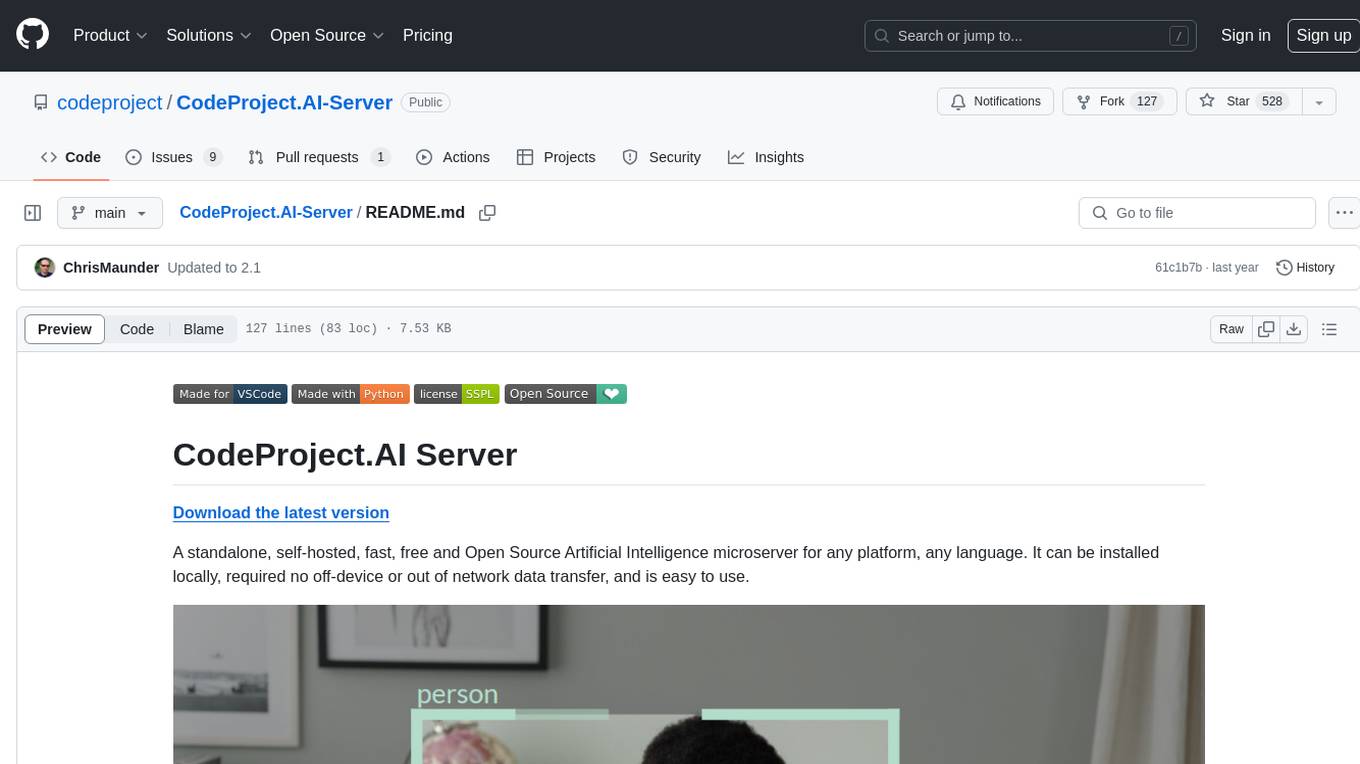
CodeProject.AI-Server
CodeProject.AI Server is a standalone, self-hosted, fast, free, and open-source Artificial Intelligence microserver designed for any platform and language. It can be installed locally without the need for off-device or out-of-network data transfer, providing an easy-to-use solution for developers interested in AI programming. The server includes a HTTP REST API server, backend analysis services, and the source code, enabling users to perform various AI tasks locally without relying on external services or cloud computing. Current capabilities include object detection, face detection, scene recognition, sentiment analysis, and more, with ongoing feature expansions planned. The project aims to promote AI development, simplify AI implementation, focus on core use-cases, and leverage the expertise of the developer community.
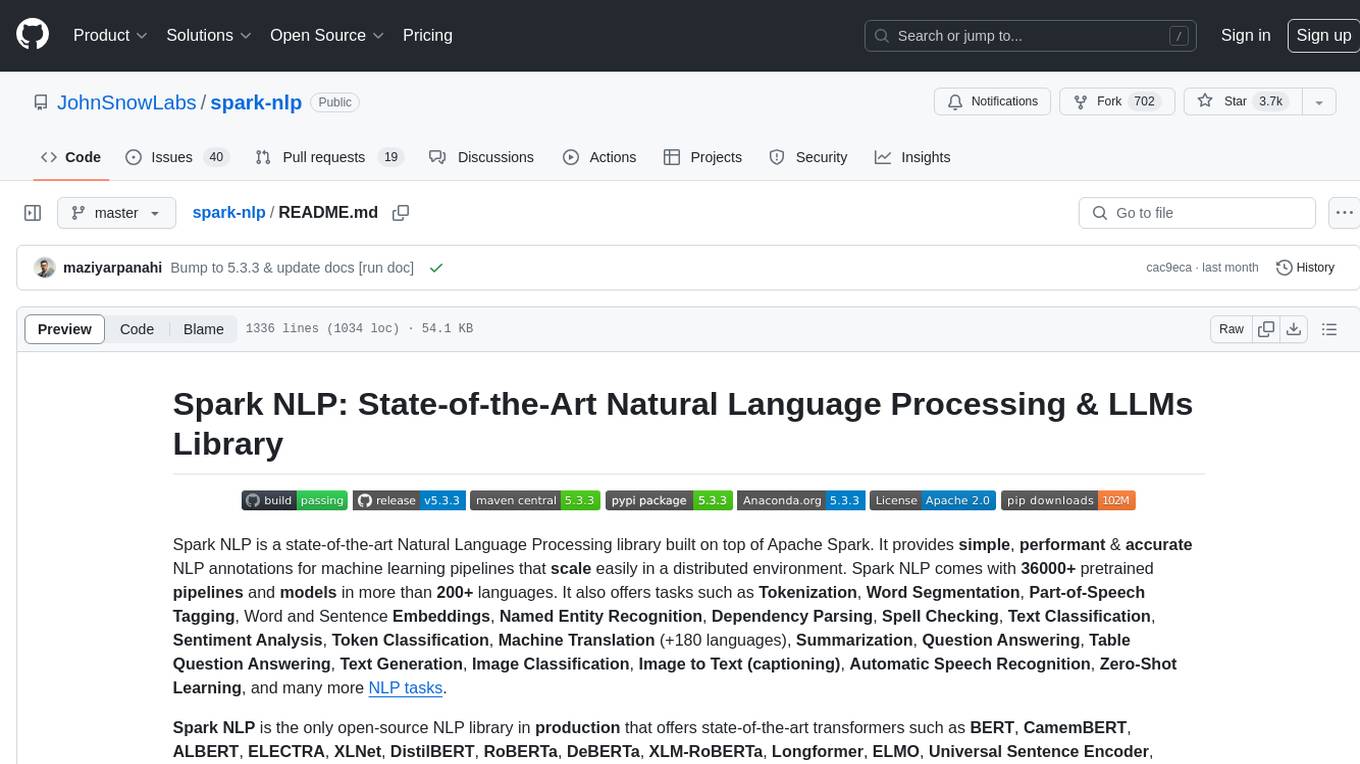
spark-nlp
Spark NLP is a state-of-the-art Natural Language Processing library built on top of Apache Spark. It provides simple, performant, and accurate NLP annotations for machine learning pipelines that scale easily in a distributed environment. Spark NLP comes with 36000+ pretrained pipelines and models in more than 200+ languages. It offers tasks such as Tokenization, Word Segmentation, Part-of-Speech Tagging, Named Entity Recognition, Dependency Parsing, Spell Checking, Text Classification, Sentiment Analysis, Token Classification, Machine Translation, Summarization, Question Answering, Table Question Answering, Text Generation, Image Classification, Image to Text (captioning), Automatic Speech Recognition, Zero-Shot Learning, and many more NLP tasks. Spark NLP is the only open-source NLP library in production that offers state-of-the-art transformers such as BERT, CamemBERT, ALBERT, ELECTRA, XLNet, DistilBERT, RoBERTa, DeBERTa, XLM-RoBERTa, Longformer, ELMO, Universal Sentence Encoder, Llama-2, M2M100, BART, Instructor, E5, Google T5, MarianMT, OpenAI GPT2, Vision Transformers (ViT), OpenAI Whisper, and many more not only to Python and R, but also to JVM ecosystem (Java, Scala, and Kotlin) at scale by extending Apache Spark natively.
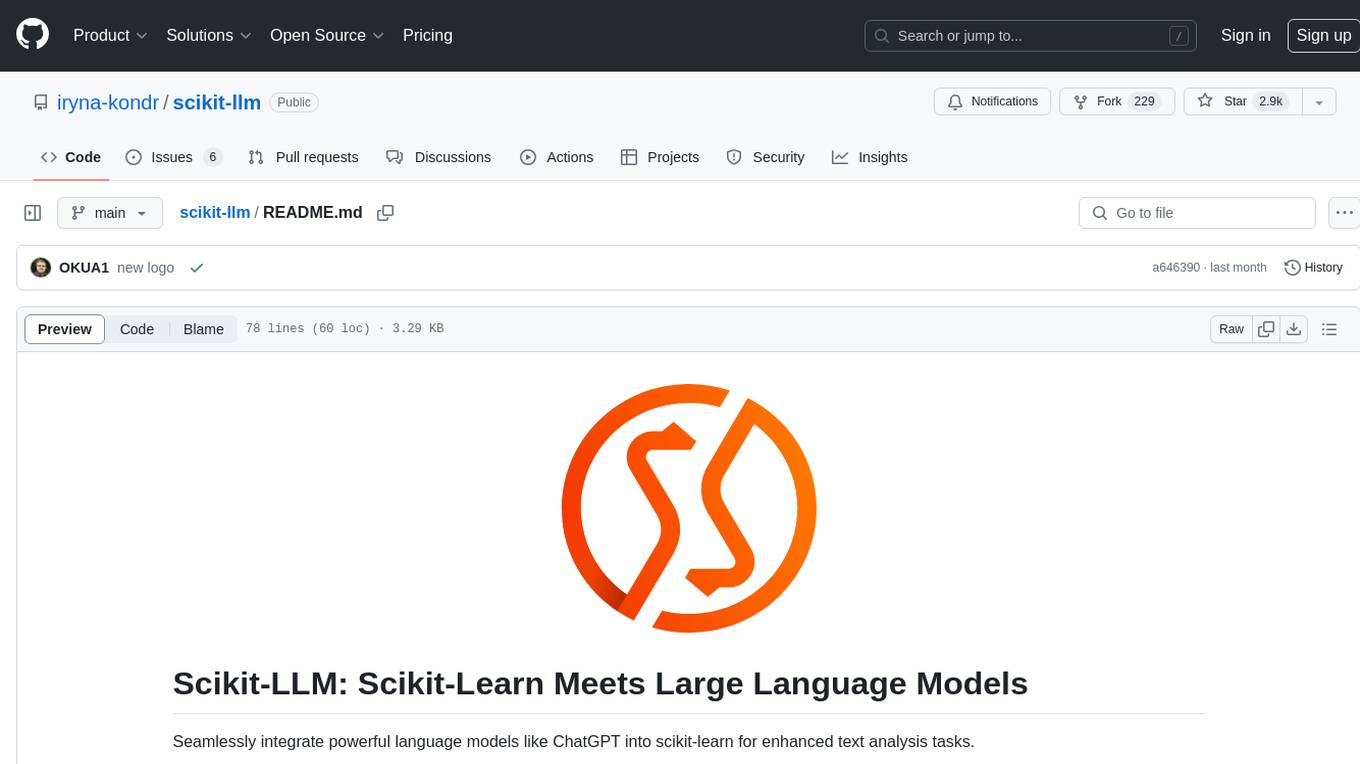
scikit-llm
Scikit-LLM is a tool that seamlessly integrates powerful language models like ChatGPT into scikit-learn for enhanced text analysis tasks. It allows users to leverage large language models for various text analysis applications within the familiar scikit-learn framework. The tool simplifies the process of incorporating advanced language processing capabilities into machine learning pipelines, enabling users to benefit from the latest advancements in natural language processing.
For similar jobs

weave
Weave is a toolkit for developing Generative AI applications, built by Weights & Biases. With Weave, you can log and debug language model inputs, outputs, and traces; build rigorous, apples-to-apples evaluations for language model use cases; and organize all the information generated across the LLM workflow, from experimentation to evaluations to production. Weave aims to bring rigor, best-practices, and composability to the inherently experimental process of developing Generative AI software, without introducing cognitive overhead.
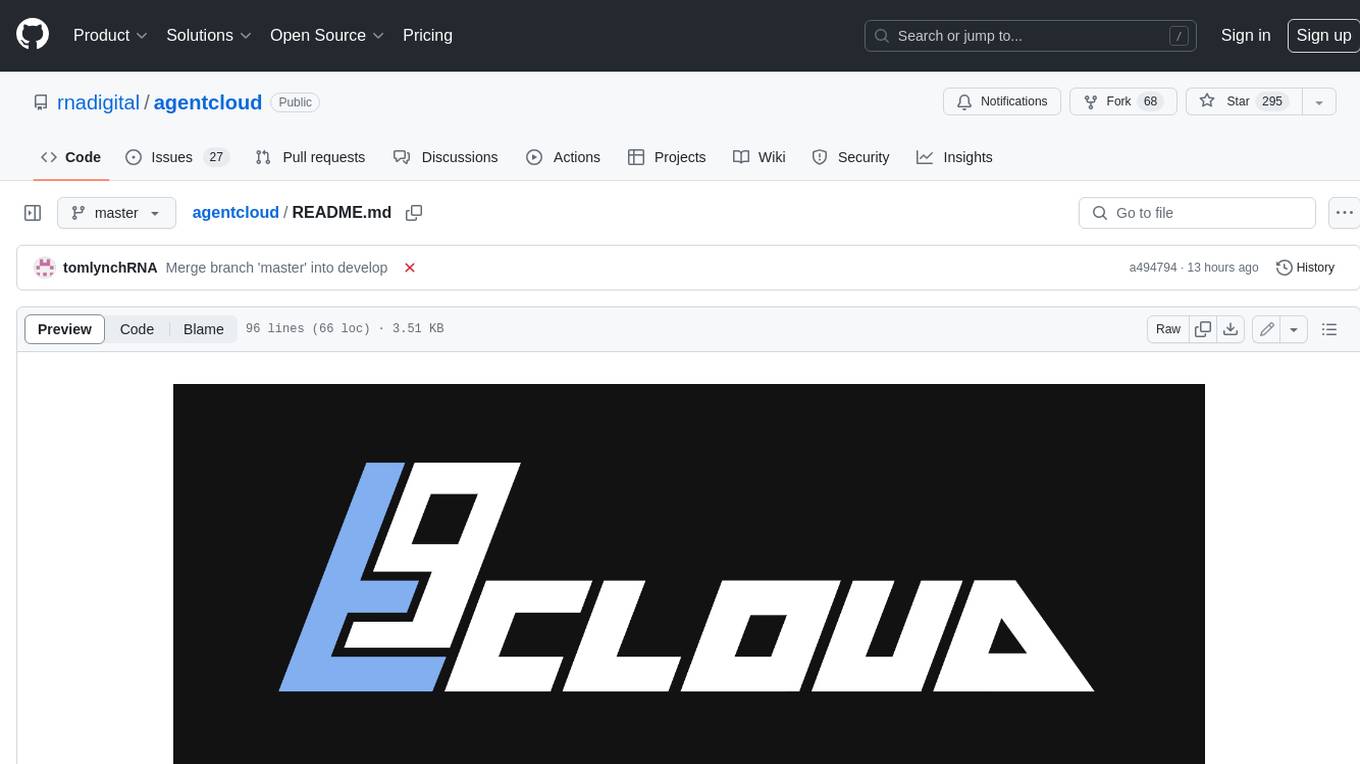
agentcloud
AgentCloud is an open-source platform that enables companies to build and deploy private LLM chat apps, empowering teams to securely interact with their data. It comprises three main components: Agent Backend, Webapp, and Vector Proxy. To run this project locally, clone the repository, install Docker, and start the services. The project is licensed under the GNU Affero General Public License, version 3 only. Contributions and feedback are welcome from the community.
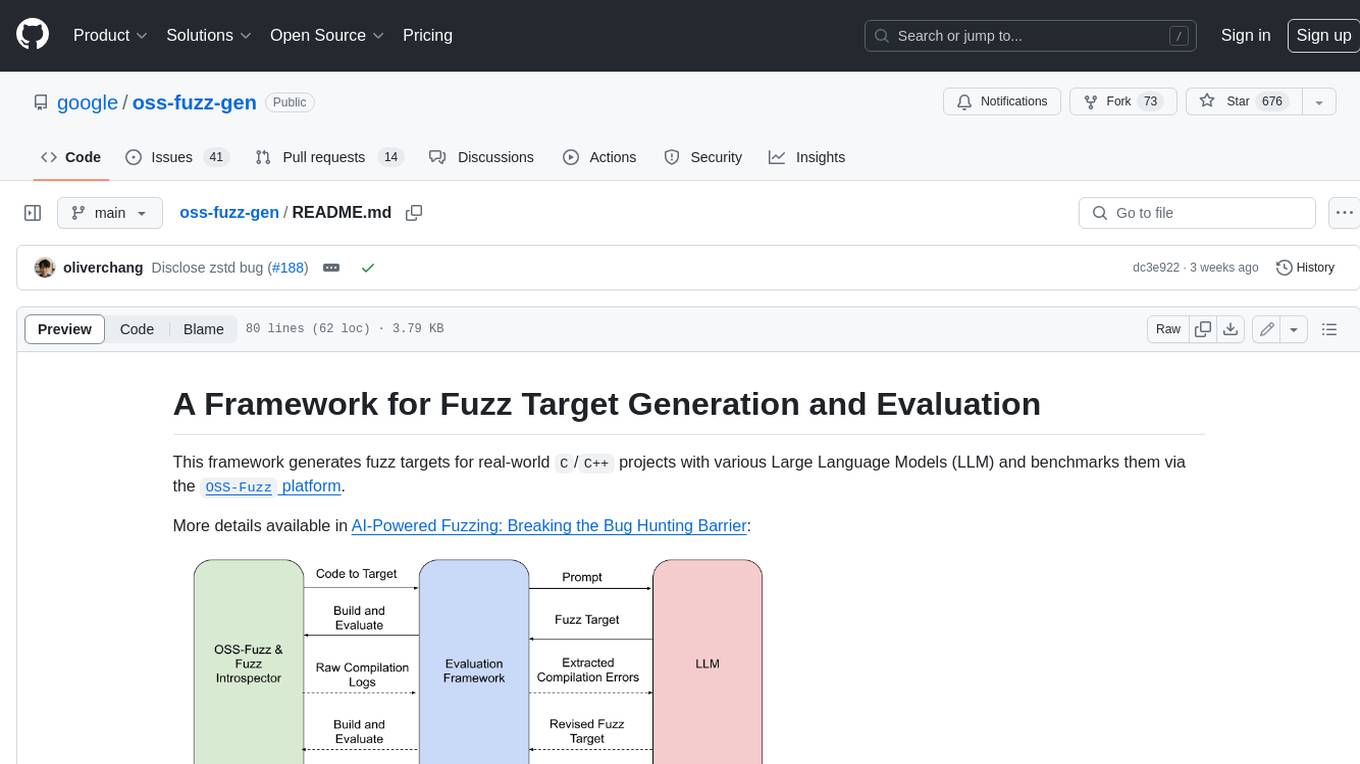
oss-fuzz-gen
This framework generates fuzz targets for real-world `C`/`C++` projects with various Large Language Models (LLM) and benchmarks them via the `OSS-Fuzz` platform. It manages to successfully leverage LLMs to generate valid fuzz targets (which generate non-zero coverage increase) for 160 C/C++ projects. The maximum line coverage increase is 29% from the existing human-written targets.

LLMStack
LLMStack is a no-code platform for building generative AI agents, workflows, and chatbots. It allows users to connect their own data, internal tools, and GPT-powered models without any coding experience. LLMStack can be deployed to the cloud or on-premise and can be accessed via HTTP API or triggered from Slack or Discord.

VisionCraft
The VisionCraft API is a free API for using over 100 different AI models. From images to sound.

kaito
Kaito is an operator that automates the AI/ML inference model deployment in a Kubernetes cluster. It manages large model files using container images, avoids tuning deployment parameters to fit GPU hardware by providing preset configurations, auto-provisions GPU nodes based on model requirements, and hosts large model images in the public Microsoft Container Registry (MCR) if the license allows. Using Kaito, the workflow of onboarding large AI inference models in Kubernetes is largely simplified.

PyRIT
PyRIT is an open access automation framework designed to empower security professionals and ML engineers to red team foundation models and their applications. It automates AI Red Teaming tasks to allow operators to focus on more complicated and time-consuming tasks and can also identify security harms such as misuse (e.g., malware generation, jailbreaking), and privacy harms (e.g., identity theft). The goal is to allow researchers to have a baseline of how well their model and entire inference pipeline is doing against different harm categories and to be able to compare that baseline to future iterations of their model. This allows them to have empirical data on how well their model is doing today, and detect any degradation of performance based on future improvements.
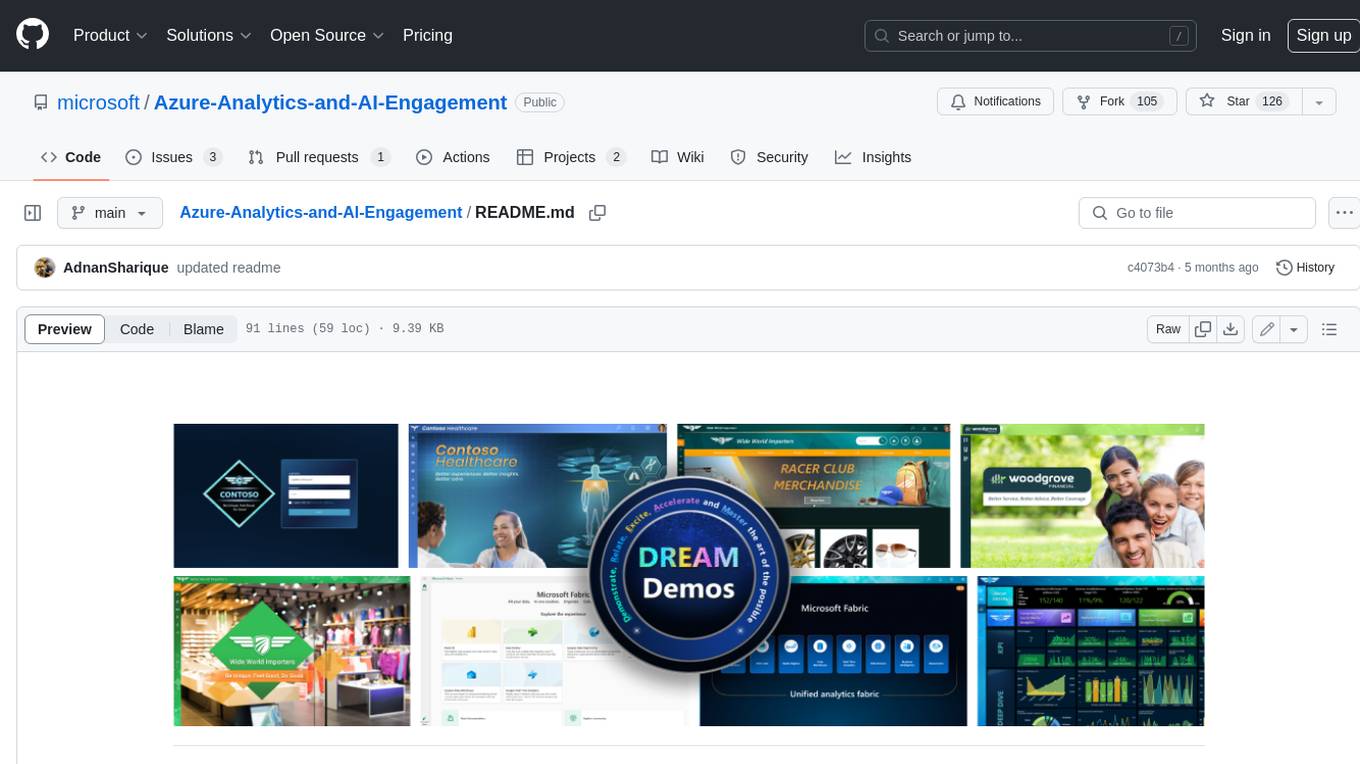
Azure-Analytics-and-AI-Engagement
The Azure-Analytics-and-AI-Engagement repository provides packaged Industry Scenario DREAM Demos with ARM templates (Containing a demo web application, Power BI reports, Synapse resources, AML Notebooks etc.) that can be deployed in a customer’s subscription using the CAPE tool within a matter of few hours. Partners can also deploy DREAM Demos in their own subscriptions using DPoC.




